2022 Annual Report for: Noctuidae / Cuculliinae
For species seen in 2022 that had less than or equal to 100 records, full details are included; for more common species, the earliest, latest and highest count by vice-county are shown. The narrative for each species is taken from the main Hantsmoths website, and it is possible that some information on abundance and occurrence can get out of date, as it is impossible to keep up with all changes; however it should give a good introduction to each species. The tables in each species account summarise the previous status, and that for the current year.
For the maps, all records prior to 2022 are shown by a blue dot (the larger the dot, the more recent), with the current year's records shown in red. As previous records are superimposed on any report for 2022, new sites have greater emphasis (i.e. will show as 'more red').
In the species accounts, an asterisk next to a location indicates a new 10km square record; earliest ever dates are highlighted in orange, and latest ever in red. Initials in the species accounts refer to the recorders listed here. Please get in touch if you identify any omissions or errors, in particular if you have records that have yet to be submitted. Details of how to submit records can be found here.
73.052 [B&F: 2216] Shark Cucullia umbratica (Linnaeus, 1758) - Common
Common in rough ground, chalk and limestone grassland, sand-dunes, shingle beaches and gardens throughout the British Isles. In Hampshire and on the Isle of Wight this species is still fairly frequent in places, especially near the coast. Wingspan 48-57 mm. The only confusion species is Chamomile Shark C. chamomillae, but C. umbratica has forewing fringes clear and unmarked, while on C. chamomillae they are cut by dark veins. Larva feeds on flowers and leaves of Beaked, Marsh, Rough and Smooth Hawk's-beard, Mouse-ear Hawkweed and Perennial Sow-thistle, over-wintering as a pupa.
Records prior to 2022
| Vice County | #Records | #Individuals | First Record | Last Record |
|---|---|---|---|---|
| 10 | 115 | 120 | 1951 | 2021 |
| 11 | 853 | 982 | 1949 | 2021 |
| 12 | 236 | 217 | 1949 | 2021 |
2022 records
| Vice County | #Records | #Individuals | Max Quantity |
|---|---|---|---|
| 10 | 4 | 4 | 1 |
| 11 | 17 | 16 | 2 |
| 12 | 6 | 7 | 2 |
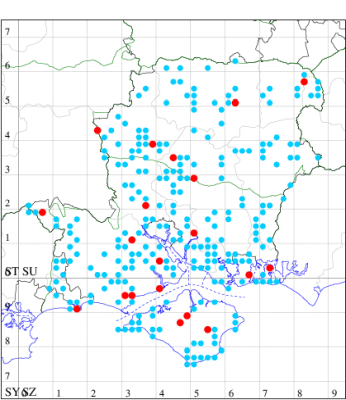
Records by year
Records by week (adult)
Records by week (larval)
Record Details
VC10: Plaish, Carisbrooke, one, 21 Jul (KRyl); Newport, one, 22 Jun; one, 11 Jul (DPl); Haseley Manor, one, 10 Jul (IOu);
VC11: Woodlands, NF, one, 23 Aug (CJon); Romsey, one, 17 Jun (MJB); Dibden Purlieu, one, 19 May; one, 05 Aug; one, 07 Aug (RAC); Botley, one, 08 Jul; one, 12 Jul (SLB); Portsmouth, one, 03 Jul; one, 21 Aug (IRT); Northney, Hayling Island, present, 31 May (JWP); Hengistbury Head, one, 06 Jun; one, 20 Jul; one, 26 Jul (MJef); Pennington, one, 08 Jul (RFC); Lymington, present, first date recorded , 27 May (PRD); Needs Ore NNR, one, 18 Jun; two, 05 Jul; one, 10 Jul (CNB);
VC12: Cholderton, one, 19 Jul (TJN); Chilbolton, one, 30 Oct; Littleton, one, 15 Aug (GCE); Morn Hill, Winchester, one, 11 Jun (CRB, DAS, PDF et al); Basingstoke, one, 17 Jun (DJJ); Minley Wood, two, field observation, 02 Jul (BGD)
73.053 [B&F: 2214] Chamomile Shark Cucullia chamomillae ([Denis & Schiffermüller], 1775) - Local
Local on calcareous grassland, waste ground, farmland and gardens; well distributed, showing a preference for sandy or light calcareous soils, and probably most common near the coasts, in England and Wales, Scotland to Perthshire, and Ireland (MBGBI Vol 10). In Hampshire and on the Isle of Wight thinly scattered through the three vice-counties, but scarcer than formerly, probably on account of changed agricultural techniques. Wingspan 42-52 mm. The most likely confusion species is Shark Cucullia umbratica, which see for differences. Larva feeds on flowers of Scentless Mayweed, Corn Chamomile, Stinking Chamomile and Feverfew, over-wintering as a pupa.
Records prior to 2022
| Vice County | #Records | #Individuals | First Record | Last Record |
|---|---|---|---|---|
| 10 | 29 | 16 | 1907 | 2021 |
| 11 | 150 | 140 | 1950 | 2020 |
| 12 | 37 | 12 | 1951 | 2020 |
2022 records
| Vice County | #Records | #Individuals | Max Quantity |
|---|---|---|---|
| 11 | 1 | 1 | 1 |
| 12 | 1 | 1 | 1 |
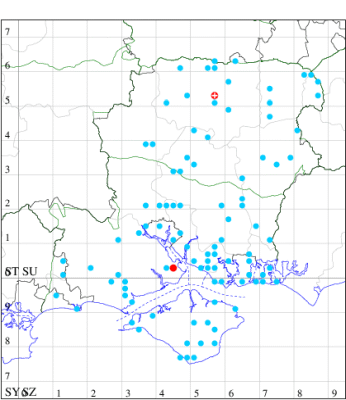
Records by year
Records by week (adult)
Records by week (larval)
Record Details
VC11: Blackfied, one, to lighted window, 09 May (PGS);
VC12: Malshangar Estate, nr Basingstoke, larva, one, field observation, 05 Jul (CLW)
73.057 [B&F: 2219] Striped Lychnis Cucullia lychnitis Rambur, 1833 - Nationally Scarce
Nationally scarce (Na) and a priority species under the UK Biodiversity Action Plan, on calcareous grassland and roadside verges. Found throughout much of the chalk outcrop of central Hampshire, extending from the South Downs of West Sussex virtually to the border with Wiltshire. It is also breeding in Oxfordshire, Berkshire and in small scattered sites over a wide area in south Buckinghamshire. Hampshire is an important national stronghold for the species, and in 2000 the moth was discovered to have colonised the recently re-seeded extension of the Magdalen Hill Down Reserve near Winchester. Not recorded from the Isle of Wight to date. Wingspan 42-46 mm. The most likely confusion species are Mullein S. verbasci, which is usually larger and brown-tinged, with a clearly defined discal spot on the underside of the hindwing, whereas Striped Lychnis is grey-tinged and does not hindwing underside dot, and Water Betony S. scrophulariae, from which reliably separable only by reference to the genitalia. Larva feeds on flowers of Dark Mullein, over-wintering as a pupa.
Records prior to 2022
| Vice County | #Records | #Individuals | First Record | Last Record |
|---|---|---|---|---|
| 11 | 248 | 1531 | 1800 | 2021 |
| 12 | 564 | 4129 | 1948 | 2021 |
2022 records
| Vice County | #Records | #Individuals | Max Quantity |
|---|---|---|---|
| 11 | 10 | 50 | 27 |
| 12 | 28 | 144 | 20 |
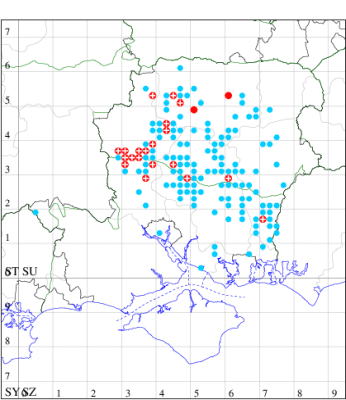
Records by year
Records by week (adult)
Records by week (larval)
Record Details
VC11: Kings Somborne, larva, one, field observation, 25 Jul; Broughton, larva, four, field observation, 10 Aug; larva, one, field observation, 24 Jul; larva, one, field observation, 10 Aug; larva, three, field observation, 24 Jul; larva, one, field observation, 10 Aug; Stockbridge, larva, one, field observation, 02 Aug; Little Somborne, larva, four, field observation, 25 Jul; larva, 27, field observation, 25 Jul (GCE); Clanfield, larva, seven, field observation, 21 Jul (MBer);
VC12: Nether Wallop, larva, 14, field observation, 24 Jul; larva, one, field observation, 10 Aug; larva, 20, field observation, 24 Jul; larva, six, field observation, 10 Aug; larva, 14, field observation, 24 Jul; larva, three, field observation, 10 Aug; Longstock, larva, 10, field observation, 10 Aug; larva, six, field observation, 10 Aug; larva, one, field observation, 25 Aug; Leckford, larva, nine, field observation, 27 Jul; larva, 16, field observation, 07 Aug; West Down, Chilbolton, larva, four, field observation, 27 Jul; Chilbolton, larva, one, field observation, 24 Jul; larva, five, field observation, 26 Jul; larva, three, field observation, 30 Jul; Hurstbourne Tarrant, larva, one, field observation, 26 Jul (GCE); Winchester, St Giles Hill Graveyard, larva, three, field observation, on one Verbascum thapsus flower spike, 30 Jul (APS det. PAB); St Giles Cemetery, Winchester, larva, four, field observation, on flowers of Verbascum thapsus , 23 Jul (PAB); Littleton, larva, five, field observation, 23 Jul; Barton Stacey, larva, one, field observation, 30 Jul; Longparish, larva, one, field observation, 30 Jul; Dunley, larva, five, field observation, 26 Jul; Cole Henley, larva, four, field observation, 26 Jul; larva, three, field observation, 26 Jul (GCE); Overton, one, 30 Jun; one, 17 Jul (ACr); Cheriton Wood, larva, one, field observation, on Dark Mullein , 03 Jul (DAS); Basingstoke, one, 22 Jun (MJW)
73.058 [B&F: 2221] Mullein Cucullia verbasci (Linnaeus, 1758) - Common
Common in calcareous grassland, woodland clearings, woodland rides, scrub, roadside verges, shingle beaches, parks and gardens throughout much of England and Wales, mostly in the south. In Hampshire and on the Isle of Wight well-distributed, partly as a result of the differing ecology of the two main food-plants. Wingspan 44-56 mm. The main confusion species are Striped Lychnis S. lychnitis and Water Betony S. scrophulariae. The larva is found on various species of mullein (Verbascum), in particular Great Mullein, but it also uses Buddleia in gardens, and not infrequently on figwort (Scrophularia sp.)
Records prior to 2022
| Vice County | #Records | #Individuals | First Record | Last Record |
|---|---|---|---|---|
| 10 | 161 | 407 | 1951 | 2021 |
| 11 | 510 | 1096 | 1951 | 2021 |
| 12 | 298 | 879 | 1951 | 2021 |
2022 records
| Vice County | #Records | #Individuals | Max Quantity |
|---|---|---|---|
| 10 | 17 | 31 | 10 |
| 11 | 23 | 29 | 6 |
| 12 | 13 | 56 | 21 |
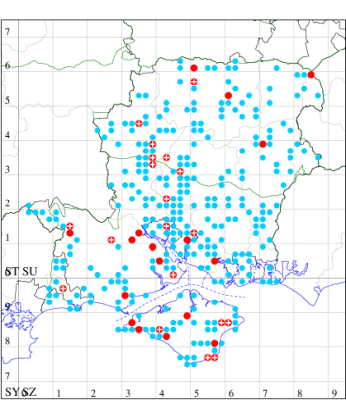
Records by year
Records by week (adult)
Records by week (larval)
Record Details
VC10: Totland, one, 17 Apr; one, 22 Apr (RTer); Freshwater Bay, one, 08 May (SDav); Mottistone Down, larva, 10, field observation, larvae on Verbascum thapsus (Great Mullein), 21 May (IOu); Brighstone, one, 01 May (AMas); Newport, one, 25 Apr; one, 26 Apr (DPl); Ventnor Botanic Garden, larva, present, field observation, 03 Jun (TFor); Wheelers Bay, one, 22 May (ABut); Bonchurch, larva, three, field observation, 23 May (IOu); one, 28 Mar; one, 16 Apr; one, 17 Apr; one, 20 Apr (JHa); Shanklin, one, 30 Apr (IOu); Nunwell, larva, three, field observation, 03 Jun (DFai); Brading Down, larva, three, field observation, lots of frass on Verbascum thapsus but only two larvae noted and one early instar larva found on Scrophularia auriculata, 06 Jun (IOu);
VC11: Fordingbridge, one, 22 Apr; one, 12 May (SCT); Langley, larva, six, field observation, eating Mulliein plant, 02 Jun (DGS); Newtown, NF, larva, present, field observation, 02 Jul (iNat); Marchwood, one, 12 Apr; one, 23 Apr; one, 03 May (CTha); Woodlands, NF, larva, present, field observation, 26 May (RBW); Totton, one, 20 Apr; one, 21 Apr; one, 22 Apr (LHan); Winter Down Copse, Little Somborne, larva, one, 17 Jun (GCE); Dibden Purlieu, one, 25 Apr (RAC); Blackfield, larva, one, field observation, 14 Jun (SJJ); Highfield, larva, one, field observation, 03 Jun (PAB); The Grove, Southampton, present, field observation, 22 May (iNat); Chandler's Ford, larva, two, field observation, 21 Jun (AJB, LB); Fareham, , one, 24 Apr (ADT); Botley, larva, one, field observation, 27 May (SLB); Hurn, larva, four, field observation, feeding on Verbascum olympicum. 14 larvae 2 weeks ago, 22 Jun (MJef); Pennington, one, 04 Apr; one, 28 Apr; one, 01 May (RFC);
VC12: Stockbridge Down, larva, one, field observation, on Dark Mullein flower spike, 02 Jul (AJB, LB); Chilbolton, larva, 21, field observation, mostly tiny, probably more if I'd searched, 21 May (GCE); Andover, larva, one, field observation, 02 Jun (GSD); Crawley, larva, five, field observation, 26 May (GCE); Littleton and Harestock, Winchester, larva, present, field observation, 13 Jul (iNat); Combe Hole, nr Kingsclere, larva, 20, field observation, 31 May (ACB); Ecchinswell, larva, one, field observation, larva feeding on Great Mullein, 14 Jun (MJN); Basingstoke, one, 24 Apr; two, 02 May; one, 22 Jun (MJW); Alton, one, 29 Mar (DBO); Blackwater, one, 11 Apr; one, 22 Apr (BGD)
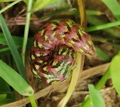
.jpg)